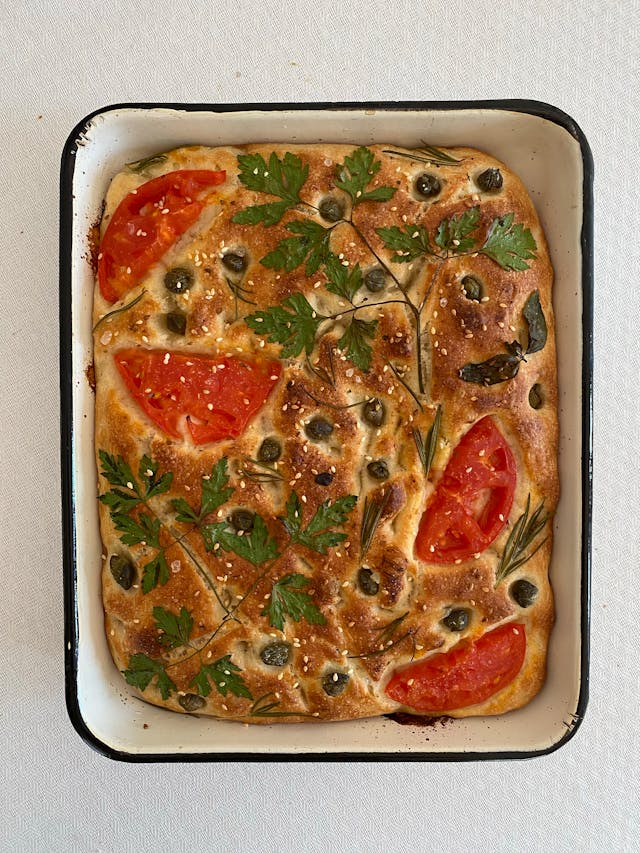Few breads evoke the sheer joy and rustic comfort of freshly baked focaccia. With its golden crust, fluffy crumb, and signature dimpled surface, focaccia is more than a bread—it’s a celebration of Italian culinary artistry. Whether adorned with rosemary, sea salt, or inventive toppings, focaccia has found its way from ancient hearths to trendy bakeries and home ovens worldwide. Let’s explore the magic behind this iconic bread, its history, and why it deserves a starring role in your kitchen.
A Slice of History: Focaccia’s Origins
Focaccia dates back to the days of Ancient Rome, when it was known as panis focacius. The word “focaccia” itself comes from “focus,” the Latin word for hearth or fireplace. Early Romans would bake this flatbread over hot coals, resulting in a smoky, aromatic loaf that quickly became a staple of Mediterranean life. Over the centuries, regional variations sprang up along Italy’s coasts and countrysides, each infused with local flavors and traditions.
The Art of Making Focaccia: Simplicity Meets Flavor
At first glance, focaccia is a humble bread—just flour, water, salt, olive oil, and yeast. Yet, its beauty lies in the details. The dough is soft and airy, given time to rise and develop a delicate gluten structure. Generous amounts of extra-virgin olive oil are used, both mixed into the dough and drizzled atop before baking. This ensures a crisp, flavorful crust that shatters gently when bitten into.
Right before baking, bakers poke deep dimples into the dough with their fingertips. Not only does this create focaccia’s unique appearance, but it also helps the olive oil and toppings pool in the indentations, creating pockets of flavor.
Toppings to Tempt Every Palate
Classic Ligurian focaccia is finished with a sprinkle of flaky sea salt and an infusion of fresh rosemary, but creativity knows no bounds:
- Herbs: Sage, thyme, basil, oregano
- Vegetables: Cherry tomatoes, caramelized onions, olives, roasted garlic
- Cheese: Feta, parmesan, goat cheese
- Sweet Twists: Grapes, figs, honey, and even chocolate chips for dessert focaccia
Part of focaccia’s enduring appeal is its adaptability. It can be the centerpiece of a meal, a hearty sandwich base, or even a sweet treat.
Focaccia in Modern Cuisine
From street food stalls in Genoa to artisanal bakeries in New York and Paris, focaccia is revered by chefs and foodies alike. It’s often the breadbasket star at Italian restaurants, served alongside olive oil and balsamic vinegar for dunking. Creative cooks repurpose it in sandwiches, use it as a pizza base, or cube it for flavorful croutons in salads.
A recent food trend is the “focaccia garden”—bread decorated with artful arrangements of vegetables and herbs to mimic blooming gardens. These edible masterpieces are as delightful to look at as they are to eat.
The Homemade Focaccia Experience
Making focaccia at home is an achievable and rewarding project, even for novice bakers. The dough requires a gentle touch, patience for rising, and an abundance of good olive oil. The intoxicating scent that fills your kitchen as it bakes is a reward in itself.
Tips for Perfect Focaccia:
- Use a high-quality extra-virgin olive oil—it’s the star of the show.
- Don’t rush the rising process; an overnight ferment in the fridge deepens the flavor.
- Get creative with toppings—let the season guide you.
- For extra-crispy edges, bake in a cast-iron pan or generously oil your baking tray.
Why We Love Focaccia?
Focaccia’s universal appeal comes from its beautiful simplicity and its ability to connect us to generations of bakers before us. Every bite tells a story—of Italian roots, Mediterranean sun, and the timeless joy of sharing focaccia bread at the table. Whether eaten plain, stuffed with meats and cheeses, or topped with veggies from your garden, focaccia brings warmth, flavor, and a touch of artistry to everyday life.

